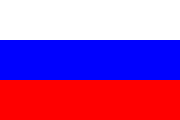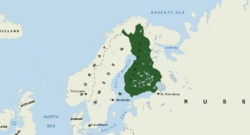Grand Duchy of Finland
|
|||||||||||||||||||||||||||||||||||||||||||||||||||||||||||||||||
The Grand Duchy of Finland (Latin: Magnus Ducatus Finlandiæ, Russian: Великое княжество Финляндское ''Velikoe knjažestvo finljandskoe) was the predecessor state of modern Finland that existed in its territory 1809–1917 as part of the Russian Empire.
Contents |
History
An extended Finland Proper was made a titular Grand Duchy (more correctly, Grand Principality) in 1581, when King John III of Sweden, who as a prince had been the Duke of Finland (1556–1561/63), extended the list of subsidiary titles of the Kings of Sweden considerably. The new title Grand Duke of Finland did not result in any increase of Finnish autonomy. During the next two centuries, the title was used by some of John's successors on the throne, but not all. Usually it was just a subsidiary title of the king, used only on very formal occasions. However, in 1802 as an indication of resolve to keep Finland within Sweden in the face of increased Russian pressure, King Gustav IV Adolf gave the title to his new-born son, Prince Carl Gustaf, who died three years later.
During the Finnish War between Sweden and Russia, the four Estates of occupied Finland were assembled at the Diet of Porvoo on March 29, 1809 to pledge allegiance to Alexander I of Russia. Following the Swedish defeat in the war and the signing of the Treaty of Fredrikshamn on September 17, 1809, Finland became a true autonomous grand duchy as a part of the Russian Empire. For the foundation of the Grand Duchy as an entity with relatively greater autonomy within the Russian realm, and for regaining of the so-called Old Finland that was lost to Russia in the previous century, the Finnish-born Gustaf Mauritz Armfelt, councillor to the emperor, was instrumental.
The history of the Grand Duchy can briefly be characterised as:
- 1809–1862: fifty years of consolidation, during which the Grand Duchy's authorities succeeded in convincing the Russian court not only of their own loyalty, but of that of all Finns.
- 1863–1898: thirty-five years of increased independence, including the re-establishment of the Diet of Finland and the elevation of Finnish from a language for the common people to a national language equal to Swedish
- 1899–1917: twenty years of attempted russification, ultimately unsuccessful and detrimental for Finland's relationship with the Russian Empire (and the Soviet Union that was formed shortly afterwards).
Politics
The constitutional status of Finland was not codified before the February Manifesto of 1899, by which time Finns and Russians had developed quite different ideas about the status of Finland. The autonomy of Finland was at first encouraged by the Russians in part due to the relatively developed governmental structures in Finland (as compared to the emperor-centered Russia of early 19th century) and in part as a deliberate policy of goodwill to win over the minds of the Finnish people. The autonomous status lead Finns to develop their own ideas of nationalism and constitutional monarchy, which they could to a large extent implement in practice with the assent of the Tsar. However, while each tsar at the time of their coronation did agree to uphold the special status of the local laws in Finland, there is no evidence that they understood their position as one of a constitutional monarch, despite the growing prevalence of such an interpretation in Finland in the latter part of the 19th century. As governmental organizations developed in Russia, and unity of the empire became one of the leading tenets of Russian politics, clashes between the Russian and Finnish governmental organizations grew frequent and lead to the attempted russification.
Finland nevertheless enjoyed a high degree of autonomy, until its independence in 1917. In 1917, after the February Revolution in Russia, Finland's government worked towards securing and perhaps even increasing Finland's autonomy in domestic matters. On December 6, 1917, shortly after the October Revolution in Russia, Finland declared its independence. Prince Frederick Charles of Hesse was elected the new monarch as king instead of grand duke, marking the new status of the nation, but he never reigned, as a republic was proclaimed.
The emperor ruled as the Grand Duke of Finland and was represented in Finland by the Governor-General of Finland. The Senate of Finland was the highest governing body of the Grand Duchy, and was composed of native Finns. In St. Petersburg Finnish matters were represented by the Finnish Minister Secretary of State. From 1863 onwards the Diet of Finland convened regularly. In 1906, the Diet, with its hereditary rather than universally elected representation, was dissolved and the modern Parliament of Finland was established. As one of the first regions in the world, Finland implemented universal suffrage and eligibility, including both women and landless people.
Geography
The Grand Duchy of Finland lay approximately within the same borders that had existed before the Moscow Peace Treaty of 1940. The main difference was Petsamo, which was ceded to Finland only in the Treaty of Tartu in 1920.
Provinces

The administrative division of the grand duchy followed the Russian imperial model with provinces (Russian: губерния governorate, Swedish: län, Finnish: lääni) headed by governors. However few changes were made and as the language of the administrators was still Swedish the old terminology from during the Swedish time continued in local use. The Viipuri Province was not initially part of the grand duchy, but in 1812 it was transferred by Tsar Alexander I from Russia proper to Finland. After 1831 there were eight provinces in the grand duchy until the end and that continued in the independent Finland:
- Turku and Pori Province (Russian: Або-Бьернеборгская губерния, Swedish: Åbo och Björneborgs län, Finnish: Turun ja Porin lääni)
- Kuopio Province (Russian: Куопиоская губерния, Swedish: Kuopio län, Finnish: Kuopion lääni)
- Vaasa Province (Russian: Николайстадская губерния, Swedish: Nikolaistads län, Finnish: Nikolainkaupunkin lääni)
- Uusimaa Province (Russian: Нюландская губерния, Swedish: Nylands län, Finnish: Uudenmaan lääni)
- Mikkeli Province (Russian: Санкт-Михельская губерния, Swedish: St. Michels län, Finnish: Mikkelin lääni)
- Häme Province (Russian: Тавастгусская губерния, Swedish: Tavastehus län, Finnish: Hämeen lääni)
- Oulu Province (Russian: Улеаборгская губерния, Swedish: Uleåborgs län, Finnish: Oulun lääni)
- Viipuri Province (Russian: Выборгская губерния, Swedish: Viborgs län, Finnish: Viipurin lääni)
Heraldry
- Main articles: Flag of Finland, Coat of Arms of Finland
The arms were originally designed for the sarcophagus of Gustav Vasa around 1580. The arms were adopted also for the grand duchy, though the position of the "eastern" sword was changed later in the 19th century so that the lion was holding it in his other arm instead of walking over it.
In the 1860s talk about a Finnish flag started in the fennoman movement. In 1863 numerous proposals were presented for a national flag. [1] The two main proposals were flags based on red/yellow and blue/white. The flag proposals never had a chance to be presented to the Diet, so none of them ever became an official flag, however people used different designs for flags of their own choosing.
See also
- Diet of Finland
- Military of the Grand Duchy of Finland
See also
- Congress Poland - Kingdom of Poland (1815-1831), another constitutional monarchy within the Russian Empire
- Grand Duchy of Lithuania
- Russification
External links
- The text of The Imperial Manifesto of 1811 in German and Finnish
- Article on Finland in 1911 Encyclopedia Britannica


